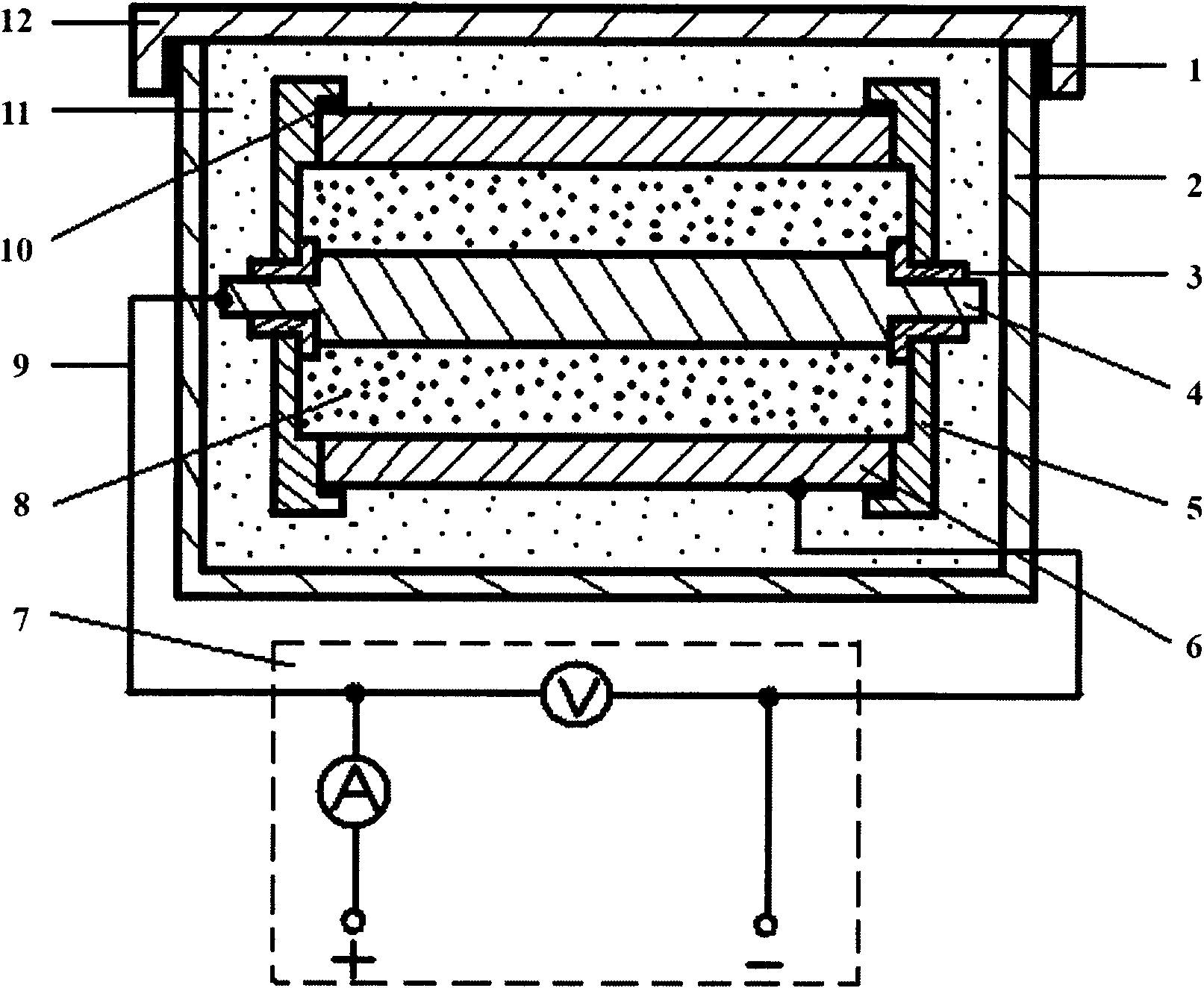Boronizing method and device for inner surface of tubular component by using direct-current electric field enhanced powder method
A DC electric field and inner surface technology, applied in metal material coating process, coating, solid-state diffusion coating, etc., can solve the problems of low utilization rate of penetrating agent, high processing temperature, long processing time, etc., and shorten the heat preservation time, reduce the temperature of boronizing, and the effect of simple device
- Summary
- Abstract
- Description
- Claims
- Application Information
AI Technical Summary
Problems solved by technology
Method used
Image
Examples
Embodiment 1
[0020] Material to be infiltrated: seamless steel pipe made of 08Cr2AlMo steel, the outer diameter of the steel pipe is 25mm, the inner diameter is 20mm, and the length is 30mm; boronizing agent composition: boron donor (boron carbide, content 2%), activator and infiltration agent (sodium fluoroborate , 2%), bulking agent (charcoal, 2%), filler and activator (silicon carbide, balance);
[0021] Fill the solid powder boronizing agent 8 composed of the above materials into the steel pipe sample 6 to be boronized on the inner wall, place the cylindrical electrode 4 in the boronizing agent, the distance between the cylindrical electrode 4 and the inner wall of the steel pipe 6 to be infiltrated is 8mm, and the two ends of the steel pipe 6 Install sealing cover 5 and insulating cover 3 at both ends of cylindrical electrode 4, and seal with refractory mud sealing material 10 again. The cylindrical electrode 4 is used as the positive pole, the steel pipe 6 is used as the negative pol...
Embodiment 2
[0024] Material to be infiltrated: seamless steel pipe made of 08Cr2AlMo steel, the outer diameter of the steel pipe is 25mm, the inner diameter is 20mm, and the length is 30mm; the composition of boronizing agent: boron supply agent (iron boron, content 5%), activator and infiltration agent (potassium fluoroborate , 5%; ammonium chloride, 2%), loosening agent (charcoal, 5%), filler and activator (silicon carbide, balance);
[0025] The boronizing method and device are the same as in Example 1, the boronizing temperature: 850°C, the boronizing time is 4 hours, the distance between the cylindrical positive electrode and the infiltrated steel pipe sample (negative electrode) is 8mm, and 35mm is applied between the cylindrical positive electrode and the infiltrated steel pipe Volts of DC electric field. Test results: 170μm boronizing layer was obtained on the inner wall of 08Cr2AlMo steel pipe, and its hardness was 1200~1700HV 0.1 ; while adopting the same infiltrating agent for...
Embodiment 3
[0027] Material to be infiltrated: seamless steel pipe made of 08Cr2AlMo steel, the outer diameter of the steel pipe is 25mm, the inner diameter is 20mm, and the length is 30mm. , 5%; ammonium chloride; 1%), loosening agent (charcoal, 5%), filler and activator (silicon carbide, balance);
[0028] The boronizing method and device are the same as in Example 1, the boronizing temperature is 700°C, the boronizing time is 4 hours, the distance between the cylindrical positive electrode and the infiltrated steel pipe sample (negative electrode) is 8mm, and the distance between the cylindrical positive electrode and the infiltrated steel pipe sample is Apply a DC electric field of 40 volts. Test results: 70μm boronizing layer was obtained on the inner wall of 08Cr2AlMo steel pipe, and its hardness was 1200~1500HV 0.1 ; while using the same infiltration agent formula, using the existing conventional powder boronizing process, the same boronizing at 700 ° C × 4 hours, the thickness of...
PUM
| Property | Measurement | Unit |
|---|---|---|
| melting point | aaaaa | aaaaa |
| length | aaaaa | aaaaa |
Abstract
Description
Claims
Application Information
 Login to View More
Login to View More - R&D
- Intellectual Property
- Life Sciences
- Materials
- Tech Scout
- Unparalleled Data Quality
- Higher Quality Content
- 60% Fewer Hallucinations
Browse by: Latest US Patents, China's latest patents, Technical Efficacy Thesaurus, Application Domain, Technology Topic, Popular Technical Reports.
© 2025 PatSnap. All rights reserved.Legal|Privacy policy|Modern Slavery Act Transparency Statement|Sitemap|About US| Contact US: help@patsnap.com


